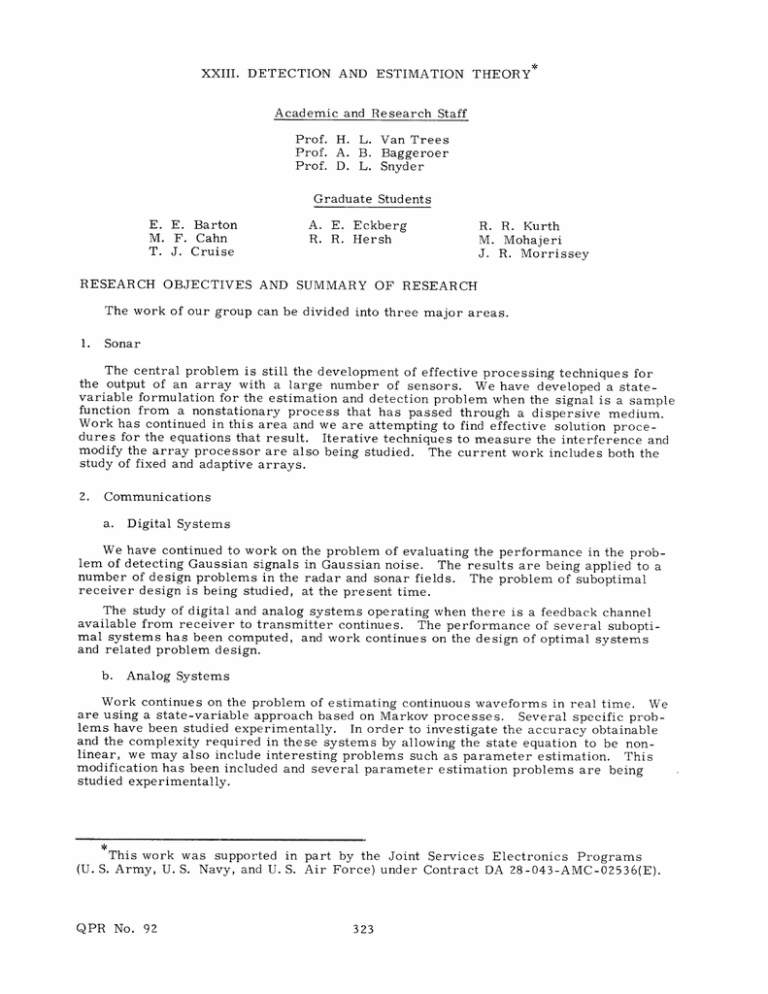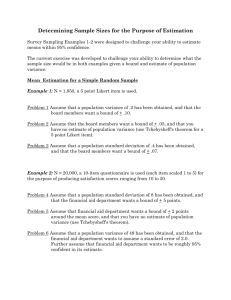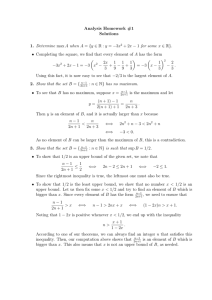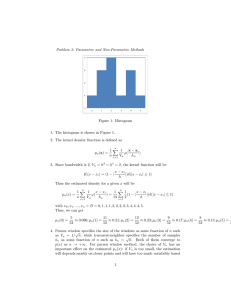XXIII. DETECTION AND ESTIMATION THEORY
advertisement

XXIII. DETECTION AND ESTIMATION
THEORY
Academic and Research Staff
Prof. H. L. Van Trees
Prof. A. B. Baggeroer
Prof. D. L. Snyder
Graduate Students
E. E. Barton
M. F. Cahn
T. J. Cruise
A. E. Eckberg
R. R. Hersh
R. R. Kurth
M. Mohajeri
J. R. Morrissey
RESEARCH OBJECTIVES AND SUMMARY OF RESEARCH
The work of our group can be divided into three major areas.
1.
Sonar
The central problem is still the development of effective processing techniques for
the output of an array with a large number of sensors. We have developed a statevariable formulation for the estimation and detection problem when the signal is a sample
function from a nonstationary process that has passed through a dispersive medium.
Work has continued in this area and we are attempting to find effective solution procedures for the equations that result. Iterative techniques to measure the interference and
modify the array processor are also being studied.
The current work includes both the
study of fixed and adaptive arrays.
2.
Communications
a.
Digital Systems
We have continued to work on
lem of detecting Gaussian signals
number of design problems in the
receiver design is being studied,
the problem of evaluating the performance in the probin Gaussian noise. The results are being applied to a
radar and sonar fields. The problem of suboptimal
at the present time.
The study of digital and analog systems operating when there is a feedback channel
available from receiver to transmitter continues. The performance of several suboptimal systems has been computed, and work continues on the design of optimal systems
and related problem design.
b.
Analog Systems
Work continues on the problem of estimating continuous waveforms in real time. We
are using a state-variable approach based on Markov processes. Several specific problems have been studied experimentally. In order to investigate the accuracy obtainable
and the complexity required in these systems by allowing the state equation to be nonlinear, we may also include interesting problems such as parameter estimation. This
modification has been included and several parameter estimation problems are being
studied experimentally.
This work was supported in part by the Joint Services Electronics Programs
(U. S. Army, U. S. Navy, and U. S. Air Force) under Contract DA 28-043-AMC-02536(E).
QPR No. 92
323
(XXIII. DETECTION AND ESTIMATION THEORY)
3.
Random Process Theory and Applications
a.
State-Variable and Continuous Markov Process Techniques
Previously, we have described an effective method for obtaining solutions to the
Fredholm integral equation. As a part of this technique we found the Fredholm determinant. Subsequent research has shown that a similar determinant arises in a number
of problems of interest. Specifically, we have been able to formulate several interesting
design problems and carry through the solution. Work in this area continues.
b.
System Identification Problem
The system identification problem is still an item of research. Applications of interest include measurement of spatial noise fields, random-process statistics, and linear
system functions.
c.
Detection Techniques
Various extensions of the Gaussian detection problem are being studied. A particular topic of current interest is the detection of non-Gaussian Markov processes.
H. L. Van Trees
A.
BARANKIN BOUND ON THE VARIANCE OF ESTIMATES OF
THE PARAMETERS OF A GAUSSIAN RANDOM PROCESS
1.
Introduction
In many problems of interest, one wants to determine how accurately he can estimate
parameters that are imbedded in a random process.
Often this accuracy is expressed
in terms of a bound, usually the Cramer-Rao bound.l
Unless, however, one can verify
the existence of an efficient or possibly an asymptotically efficient
bound,
the tightness of the result remains a question.
estimate for this
This is particularly true in the
threshold region.
The issue of tighter bounds then remains.
this is the Bhattacharyya bound.1
Probably the most common response to
One can derive, however, a bound that is optimum,
that it is the tightest possible. This is the Barankin bound.
Two forms for this bound have appeared.
has shown that for any unbiased estimate a(R),
We present them briefly here.
Barankin
the greatest lower bound on the variance
is given by
n
Z a.h.
Var [a(R)-A] >
{ai }, {hi
rr
E
QPR No. 92
2
(1)
i= 1
max
(R A+h1)2
t
I a.
i= 1 1p
324
in
2
(R A)
(XXIII. DETECTION AND ESTIMATION THEORY)
The maximization is done over the set {a i } of arbitrary dimension, n, and the set {h i }
such that the ratio Pr a(R A+hi)/Pr a(R IA) E L2 and A + h is contained in the parameter
space.
Keifer has put the bound as expressed in Eq. 1 in functional form. 3 ' 4
[5
Hf(H)
dH
(2)
Var [a(R)-A] >- max
Pr rI
[f(H)]
A+H)
E
[Note:
Barankin
f(H) dH
considered the bound for the sth absolute central moment,
Keifer considered the variance only; however,
while
his derivation is easily generalized
by applying a Minkowski inequality rather than the Schwarz inequality.
assumed that f(H) could be expressed in terms of the difference
Keifer also
of two densities.
Although the optimum choice of f(H) has this property, there is no apparent reason
to assume this a priori.]
Several applications of this bound to estimating the parameters of processes have
These all consider the problem of estimating the param-
appeared in the literature.
eter when it is imbedded in the mean of a Gaussian random process, that is,
T o < t < Tf,
r(t) = m(t, A) + n(t),
(3)
where m(t, A) is conditionally known to the receiver, and n(t) is an additive noise that
is a Gaussian random process whose statistical description does not depend on A.
In this report we want to consider the situation when one has
r(t) = s(t:A) + n(t),
T
o -< t < Tf,
(4)
where s(t:A) is a Gaussian random process whose covariance, Ks(t, u:A), depends on A,
and n(t) is an additive Gaussian noise.
For simplicity, we assume:
(a) that s(t:A)
has a zero mean, and (b) n(t) is a white process of spectral height No/2.
S
mean simply introduces terms whose analysis has already been treated.
Putting a finite
5-8
If n(t) is
nonwhite, it can be reduced to the case above by the customary whitening arguments.
We shall use Keifer's expression in Eq. 2 in our development.
It is useful to write
Eq. 2 in a slightly different form by exchanging the squaring and expectation operation
in the denominator.
This yields
[f Hf(H) dH] 2
(
Var [a(R)-A] > max
f (H)
QPR No. 92
,
ff f(H
1)
G(H1, H2:A) f(H) dHIdH 2
325
(5)
(XXIII. DETECTION AND ESTIMATION THEORY)
where all integrals are over the domain of definition for G(H 1, H 2 :A), and
PrIa(R A+H1)
G(H,
H 2 :A) = E
Pa
R
Pri(R
pra
Prla(R A+H2 )
-
A) P(
A) pr
A
)
(R A)
(R A+H 1 ) PrIa(R A+H 2 )
=
dR.
(6)
)
Pr! a(R A+H2
R
In this form there are essentially three relatively distinct issues in calculating the
bound:
1.
an effective computational method for evaluating the function G(H 1 , H 2 :A);
2.
the optimal choice of the function f(H) so as to maximize the right side of Eq. 5;
and
effective computational alogrithms for implementing the bound.
We shall focus our discussion on the evaluation of G(H 1, H 2 :A), since this is the manner
in which applying the bound for estimating the parameters of process essentially differs
3.
from what has been done previously.
We shall then make some comments on the second
and third issues as they relate to applying the bound.
2.
Evaluation of the Function G(H 1, H 2 :A)
When the parameter to be estimated is imbedded simply in the mean of the observed
process, the calculation of G(H 1, H 2 :A) is relatively straightforward.5, 6 We want to
consider the situation when the parameter is imbedded in the covariance function. Essentially, our approach is first to assume that we are working with a sampled version of
the signal, next to derive the resulting bound, and then to let the sampling interval
become vanishingly small.
Let us assume that we are using a finite time averaging for our sampler.
Then we
observe samples of the form
(n+)AT
nT
1
rn =
(7)
r(T) dT.
We can consider the r n to form a vector r.
If AT is small compared with any correla-
tion times of s(t:A), then the elements of the covariance matrix of r,
which we denote
by Kr(A), is given by
[K (A)
r
QPR No. 92
nm
N
K (nAT, mAT:A) + 22
s
6
AT
AT
326
(8)
(XXIII. DETECTION AND ESTIMATION THEORY)
so that we have
prI
expI
(RIA) =
1 R TK-(A) R
ex 2 -
r
-
(2rr) N/2 detl/2[K (A)]
Substituting this expression in that for G(H 1, H 2 :A), Eq. 6, we obtain
det /2[Kr(A)]
G(H
1
, H 2 :A) =
(2r)N/
2
detl/2[K (A+H 1 )] detl/2[K (A+H 2 )]
1
R] d.
K-1
S exp-1_T 1RT [K 1KR.
(A) R
(A+HI)+K _(A+H)-K
-
R
r
(10a)
Two observations are important here.
For the integral to be convergent, the matrix
1.
K
r
(A+H ) + K r
1
(A)
(A+H )-K
r
(A+H 2 )
must be positive definite.
It is easy to construct examples for which this would not be
true; consequently, there is often an inherent limitation on our choice of H
1
and H2 for
any particular example.
2.
The matrix above is symmetric; therefore,
is convergent,
if the integral does exist, that is,
it
it can be integrated conveniently by putting it into the form of a multivar-
iate Gauss density.
Doing this yields
det[K(A)] det[K(A+H
1 + KI(A+H-K(A
(10b)
G(H 1 , H :A)
det[Kr(A+H 1 )] det[Kr(A+H 2 )]
We now use some of the properties of determinants to obtain
I
d et K (A+H ) + K (A+H) - K (
G(H 1, H 2 :A)
=
K (+H) 2 ) K 1(A)]
) K(A+H
det[Kr(A)]
= det[Kr (A)]det-1/2{(Kr(A+H1) + Kr(A+H 2 )) Kr(A) - Kr(A+H
1)
Kr(A+H 2 )}.
(11)
We now want t o let the sampling interval approach zero so as to collapse this to
QPR No. 92
327
(XXIII. DETECTION AND ESTIMATION THEORY)
First, we separate the white-noise component.
functional form.
Eq.
Substituting Eq. 8 in
11 gives
N
G(H
1 , H 2 :A) = det Ks(A)
o I
+ 2 AT
N
)
Ks(A+H
X det
Ks(A) +
N
+ Ks(A+H 2 ) Ks(A) +-2
N
I +-
1
-T (Ks(A+H 1 )+K(A+H
o
2
+ (2o
N
2(
I
(AT)
2
N
))
I
(AT) 2
+
o
2~
I
(AT)2
K(A) AT
I N
s --
X det 1/2
+__
T
K (AH ) Ks(A) AT +N
2
_o~
0
N
AT (Ks(A+H 1 )+Ks(A))
AT (Ks(A+H 2 )+Ks(A)) + (N)2
( )2
- K (A+H ) Ks(A+H2 )
det
1
K(A+H2 ) Ks(A) AT
O
K (A+H ) K (A+H 2 ) AT 1 + 2Ks(A)
-
(12)
"
Next, we define the kernel
Y[t,
T:H 1 , H2 , A]
T f K (t
+
'
u:A+H
o
2
Ks(u, T:A) du
)
T
0f
f K (t,u:A+H)
-
T:A+H) du
Ks(,
+ 2K (t, T).
5
T
12,
If we examine the second determinant in Eq.
matrix plus 2/No times L(H
(t, u:H 1 , H 2 ,A); that is,
G(H
1,
QPR No. 92
H 2 :A) = det
2
1,
1 ,H 2,A),
(13)
we find that we have the identity
which is the sampled version of the kernel
we have
+ N
N0
Ks(A)
sOTI
AT X det 1/
2
328
+ N
1,
L(H 1 , H 2 :A) AT].
0
O
(14)
(XXIII.
DETECTION AND ESTIMATION THEORY)
If we now let the sample interval approach zero, we observe that each of the determinants becomes a Fredholm determinant evaluated at 2/N o , or
lim det2
AT--0
im-- det
+NKs(A
)A
o -
- : Ks(t, u: A),
=
(15)
Ks(A+H 1) Ks(A) AT + 2 Ks(A+HZ) Ks(A) AT
+
So K (A+H i) K(A+H ) AT
+ 2K (A)
H2, A)
0 detE + 20oL(H
AT--0
=
y-- :
(t,u:H
1
H 2 :A)).
(16)
[We note that the Fredholm determinant has the familiar form
oo
9
(z:K(t,u:A)) = Ii (1+zX.(A))
i=1
W
with the
Xi(A) being the eigenvalues of the homogeneous Fredholm integral equation assoThe expression for G(H 1 ,H
ciated with the kernel K(t,u:A).]
G(H
1 ,H 2
-
:A) =
:
Ks(t, u:A)
Equation 17 is our basic result.
2
:A) then becomes
(t u:H
2:A)(17)
Unless the computation of each of these Fredholm
determinant expressions is tractable, we have not made much progress.
vations are useful.
Some obser-
The first Fredholm determinant is a constant with respect to H
1
and
H 2 and it is often encountered in problems in communication theory. Its evaluation is
well understood. The operator Y[t,u:H 1, H :A] does not have any of the properties with
which we are accustomed to working.
It is generally nonsymmetric; and although we can
guarantee that the determinant is real and positive for any value
z > 2/N o , the operator itself is not necessarily positive definite.
of its argument
There are two important situations in which we can evaluate the determinants by
methods that do not involve a direct computation of the eigenvalues of the kernels.
The
first concerns stationary processes observed over long time intervals, while the second
is for the case in which the random process s(t:A) has a state variable of its generation.
The former is easier both to derive and describe, and we can discuss it conveniently
here.
The latter is straightforward, but lengthy; therefore, we simply point out the
essential points and material needed to derive its realization, and defer the actual derivation to a reference.
QPR No. 92
329
(XXIII. DETECTION AND ESTIMATION THEORY)
We assume that both s(t:A) and n(t) are stationary processes and that the interval
length, T = T
- T , is long compared with the effective correlation time of s(t:A). Under
both approach being a stationary operator and their eigen-
K and Y
these assumptions,
For the first determinant
values have the same distribution as their respective spectra.
we have
In
N0
: K(t,u:A)
In
=
00
X (A)
I + 2on1+
In n +
2
S
s
d(:A)
(:A)
(18)
2Tr
o
It is easy to verify by simple Fourier transform operations that the spectrum associated
with Y [t, u:H1, H 2 :A] is given by
SL(w:H1 , H :A) =
4-
{[Ss(c:A+H 1 ) + S(w:A+H 2 )] Ss(w:A)
- Ss(w:A+HI) Ss(w:A+H 2 )} + 2Ss(w:A).
Therefore,
(19)
we have
n
:
tu
j
1
In
-
I + --
SL(Jw:H
0
1'
H2 :A)
d
(20)
Exponentiating and substituting in the expression for G(H 1 , H 2 :A), we obtain
G(H
1 ,H 2 :A)
with SL(w:H
= exp
1,
2
n (+
T
H :A) given by Eq.
Ss(:A)
-
-n
strate that our original bound given by Eq.
we choose f(H) to be a doublet, ul(H).
G(HH
1
1
H =H=0
2
1
Straightforward differentiation and noting that
QPR No. 92
:A)
(21)
2 reduces to the Cramer-Rao bound if
2 :A)
2
2
It is straightforward to demon-
This yields
1
2
SL(w:H1H
19.
We can obtain one simple check of the ab(ove result.
Var [(R)-A] >
-
1+
330
_A
(XXIII. DETECTION AND ESTIMATION THEORY)
2
1 + ? SL (0:0,
NL
0
0:A) =
2
(23)
1 + 2 S (w:A)
Ns
0
)2
yields
a G(H
1,
2 aSs( :A)
S
aA
Soo
H2:A)
aH1 H
2
HI=H2=0
2
1+
S (w:A
0
T
2
Sn
oo
8A
+
.
S (w:A)
N
O1
0
s
2
(24)
Substituting this in Eq. 22 yields the Cramer-Rao bound for estimating the parameters
of a random process.10
We wish to obtain realization of the bound when s(t:A) is generated by a system
described by state variables.
We already know how to evaluate the Fredholm determi-
nant associated with the operation K(t,u:A).11, 12 The calculation for the determinant
associated with Y(t, u:H 1 , H 2 :A) can be derived in a manner that is essentially analogous
11
We outline this derivation briefly
to the derivation for K(t, u:A) performed previously.
now.
1.
Referring to Eq.
13 which defines the operator
2 [t, u:H1, H2:A], we see that we
can implement its operation with the block diagram in Fig. XXIII- 1.
Fig. XXIII-I.
QPR No. 92
Realization of the operator Y [t, u:H 1, H 2 :A] in terms of
covariance operations.
331
(XXIII. DETECTION AND ESTIMATION THEORY)
Using previous results 1,
we know how to specify a state-variable description of each
of the blocks in this diagram; hence the total system has a state-variable description.
Using this description and imposing the eigenfunction condition
2.
T
f [t, u:H 1, H:A] (u) du = X(t),
(25)
t<Tf,
T
0
allows us to specify a transcendental equation in terms of X whose roots are the eigenvalues of Eq. 25.
We apply a normalization to this equation and evaluate it at X = -2/No
to yield the desired Fredholm determinant. We emphasize that given the state-variable
realization of the operator, the steps in the derivation are essentially parallel to those
developed previously.11 The specific results are given elsewhere. 13
The major difficulty with this approach is that the system in Fig. XXIII-1 implies
an 8N dimensional system, where N is the dimension of the system generating s(t:A).
This large dimensionality imposes stringent computational demands for even relatively
small N, especially when the time interval, T, is large. We hope that in many particular applications this dimensionality
approach using sampling, for example,
can be reduced; for as it
11 directly, may be more expe-
evaluation of Eq.
dient from a practical computational viewpoint.
currently stands, an
We also comment that the state-variable
realization of the Cramer-Rao inequality can be derived from these results.
3.
Discussion
We have discussed a method of using the Barankin bound for bounding estimates of
the parameters of Gaussian random processes.
G(H
1
,H
2
:A).
f(H 1 ) =
where G-
We focused our attention on calculating
The optimum choice of f(H) can be shown
G-
(H 1 , H 2 :A) H 2 dH
6
to be
2,
(H 1 , H 2 :A) is the inverse kernel associated with G(H
1,
H 2 :A),
so that the bound
is given by
Var [a(R)-A] >
hjr
H1G-I(H1, H :A) H2 dHdH2
1
1
2
H2
1
2'
Due to the complexity of G(H 1, H 2 :A) as a function of H 1 and H 2 , one must resort
-1
to numerical methods for calculating either G (H 1 , H 2 :A) or the bound. This introduces
the problem of effective computational procedures.
We shall defer this issue until we
have obtained more complete numerical results than we have at present.
Some of our
comments, however, have been summarized elsewhere.13
A. B. Baggeroer
QPR No. 92
332
(XXIII. DETECTION AND ESTIMATION THEORY)
References
and Modulation Theory,
Part I (John
1.
H. L. Van Trees, Detection, Estimation,
Wiley and Sons, Inc. , New York, 1968).
2.
E. W. Barankin, "Locally Best Unbiased Estimates," Ann. Math. Statist.,
pp. 477-501, 1949.
3. J. Kiefer, "On Minimum Variance
pp. 627-629, 1953.
Estimators,"
Vol. 20,
Ann. Math. Statist. , Vol. 23,
4.
M. G. Kendall and A. Stuart, The Advanced Theory of Statistics, Vol. 2, "Inference
and Relationship" (Hafner Publishing Company, New York, 1961).
5.
P. Swerling, "Parameter Estimation for Waveforms in Additive Gaussian Noise,"
J. Soc. Indust. Appl. Math., Vol. 7, No. 2, pp. 152-166, June 1959.
6.
R. J. McAulay and L. P. Seidman, "A Useful Form of the Barankin Bound and Its
Application to PPM Threshold Analysis" (unpublished memorandum).
7.
R. J. McAulay and D. J. Sakrison, "A PPM/PM Hybrid Modulation System" (unpublished memorandum).
8.
E. M. Hofstetter, "The Barankin Bound," Laboratory Technical Memorandum
No. 42L-0059, Lincoln Laboratory, M. I. T. , Lexington, Mass., March 22, 1968.
A. J. F. Siegert, "A Systematic Approach to a Class of Problems in the Theory of
Noise and Other Random Phenomena - Part III, Examples," IRE Trans. , Vol. IT-4,
No. 1, pp. 3-14, March 1958.
9.
10.
11.
H. L. Van Trees, Detection, Estimation, and Modulation Theory, Part II (John
Wiley and Sons, Inc. , New York, 1969).
A. B. Baggeroer, "State Variables, the Fredholm Theory, and Optimal Communications," Sc. D. Thesis, Department of Electrical Engineering, M. I. T. , January
1968.
12.
L. D. Collins, "Evaluation of the Fredholm Determinant for State-Variable Covariance Functions," Proc. IEEE 56, 350-351 (1968).
13.
A. B. Baggeroer, "The Barankin Bound on the Variance of Estimates of the Paramaters of a Gaussian Random Process," Internal Memorandum, M. I. T. , November 15, 1968 (unpublished).
QPR No. 92
333







